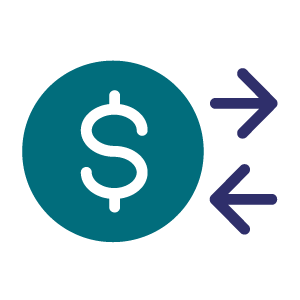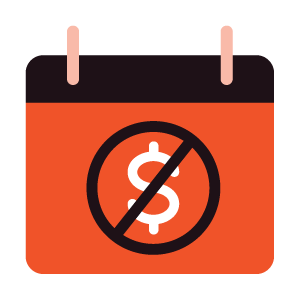Looking forward to college or university? As you plan which schools you'll apply to, what posters to put up on your dorm walls and start following your potential future alma mater's TikTok tags to get a sense of campus life, you might also want to think about your student bank account, credit card and line of credit options, and building a credit history. Why? Because doing so could save you a lot of money — and stress down the line.
This one's easy! It's a student bank account designed for day-to-day transactions. This is what you'll use to pay for your textbooks, Spotify membership and random debit purchases, like late-night pizza orders!
Financial institutions like Scotiabank offer student chequing accounts designed specifically with students and youth in mind. Many even offer a welcome bonus for signing up, like extra points for a rewards program, a cash bonus, a first-year annual fee rebate on a credit card or free tech when you sign up. Score!
Here's what to look for in chequing accounts for students:

No monthly account fees

A rewards program

Unlimited debit card transactions

Unlimited Interac e-Transfer† transactions

A welcome bonus or student offer for signing up

Bundle bonuses for when you sign up for more than one student banking service

Online banking and a mobile app, convenient branch locations and ABMs
Student chequing accounts have your back as a student. They often charge zero monthly account fees and give you unlimited debit transactions (“transactions” referring here to every time you spend money), unlimited Interac e-Transfer† transactions (perfect for splitting bill payments with friends), and account statements (those things you get every month telling you how much is in your account). Some may even offer bundle bonuses if you sign up for something else (like a savings account).
What does that mean for you? You can buy as much coffee to survive those late-night study sessions as you need without worrying about service fees or transaction charges adding up.
Scotiabank’s Preferred Package for Students and Youth is a great example — you get all the essentials plus perks like earning Scene+™ points on everyday purchases,1 free trades through Scotia iTRADE, 2 eligible overdraft protection3 for those "oops" moments and even a first-year annual fee waiver (up to $150) on select credit cards.4 You'll be eating free popcorn, booking movie tickets and stacking rewards points faster than you can say “group project.”
How to qualify for a student chequing account
Qualifying for Scotiabank’s Preferred Package for Students and Youth depends a little on your age and/or student status:
- If you're under 23, you automatically qualify — no need to show proof of school enrollment — and won't be charged monthly fees.
- If you're 23 or older, you must be a full-time student in good standing at a recognized post-secondary institution in Canada or the U.S. and provide proof of enrollment. If you’re eligible, you’ll also get $0 monthly account fees for the duration of your studies!
Bottom line? Whether you’re cramming for finals or starting your first job as a young adult, there’s a simple path to getting a great banking package that fits your life — and your wallet.
A savings account is a safe place to store money you don’t plan to spend right away. Unlike a chequing account for everyday spending, a savings account is meant to help you set money aside — and earn a little extra money, called interest, just for keeping your savings there. Think of it as the bank’s way of saying thanks for letting them hold onto your money.
Now, you might think it’s a little bold to assume you even have savings. Isn’t that something for older people with jobs and mortgages? Fair point — but many students get big chunks of money at the start of the school year from student loans or scholarships, or they save up from summer jobs. A savings account is the perfect place to park that money safely until you need it — whether it’s for rent, textbooks or a big purchase like a car to make your campus commute a little easier.
Here's what to look for in a great savings account:

No monthly account fees

No minimum balance

Higher interest rates than chequing accounts

Unlimited self-service transactions

A bank with easy mobile banking, online access and convenient branch locations and ABMs
Why you need a savings account
Why should you have your money in more than one place? Sounds more complicated than just putting it all in a chequing account, you're likely thinking.
Not so fast! Savings accounts pay you higher interest rates on the money you put in them. That's free money for doing nothing other than parking your cash somewhere safe.
One thing to note is that savings accounts are not meant for day-to-day transactions, like buying late-night snacks (read: pizza) or paying your cellphone bill. That's best paid out of a chequing account with unlimited transactions since savings accounts often charge for debit transactions.
How a savings account can help you ... in the future
Savings accounts aren’t just for rainy days. They help you build good financial habits, which later can help build a credit history or boost your credit score. Plus, transferring a little money at a time into your savings each month helps you budget and plan without dipping into your rent or tuition money.
And thanks to features like Scotia’s mobile app, you can track your saving goals and spending habits in your Scotia accounts without missing a beat.
One more thing about savings accounts: they often come with cool perks. For example, Scotia’s MomentumPlus Savings Account gives you a progressively higher interest rate the longer you save.5
Here’s the deal: applying for a Scotia student chequing account is quick and painless. Just follow these steps.
1. Open an account online or at a local branch
Don't want to leave your house? Good news — you can set up a Scotia account in just a few minutes online. You can also drop into a branch to set everything up from start to finish. Call ahead, make an appointment and you’ll be in and out in a breeze.
Eligibility for the Scotiabank Preferred Package for Students and Youth:
- 23 or older: You'll need to bring proof of enrollment at a post-secondary institution to a branch to finalize the process.
- Under the age of 23: You're automatically eligible and can open your account without enrollment proof.
2. Have the right documents ready
This one's pretty straightforward. You just need to show the right documents based on your age and student status.
- If you're under 23, bring a government-issued ID — no proof of enrollment required.
- If you're 23 or older, bring both a government-issued ID and proof that you're enrolled full-time at a recognized post-secondary institution.
- If you're between the ages of 12 and 15, bring both your government-issued ID and your parent or guardian’s government-issued ID to open the account.
You definitely want to download Scotiabank’s mobile app. It’s not just for checking your account balance — it’s your go-to for tracking your budget, keeping tabs on bill payments and seeing (in real time) just how much you’ve spent on late-night takeout. Stay on top of your money and crush your spending goals — all from your phone.
4. Fund your account
At this step, it’s time to put money into your fancy new bank account. You can do it through an Interac e-Transfer, an ABM deposit, an electronic funds transfer (where you give your current bank the details for your new account), a cheque or by visiting your local branch to make a cash deposit.
5. Set up automatic deposits
Got a part-time job? You might have to set up your payroll direct deposits to feed into your new account. All you need is your branch number, your account number and your bank's institution number (Scotia’s number is 002). Unsure what those are? You can usually find them in your online banking portal. You can also ask a local branch representative to help you or call your bank.
6. Update any pre-authorized payments
You don't want to miss a payment and accidentally cancel your monthly gift box subscription featuring all the weird but delightful stuff celebrities are using lately. Or, horror of horrors, your Netflix! Switch over any subscriptions to your new student bank account or credit card so you don't miss out.
7. Close old accounts
No need to pay banking fees on accounts you’re no longer using! So devote some free time to this task and get it off your to-do list. Once done, you’ll be all set with your student banking for the start of the new school year.
Steps to setting up a Scotia student chequing bank account

1. Open an account online or in branch

a. Have your ID and proof of enrollment (if 23 and older)

2. Set up direct deposit or deposit money into the account

3. Transfer pre-authorized payments

4. Close out old accounts
Congrats! You now have a handle of the student bank account basics
Read this far? You're now basically a student banking expert. Managing your money well is a superpower — way cooler than invisibility. With the right accounts, tools and tips, you'll be better prepared to reach your financial goals and maybe even your first big milestone — whether it's saving for a car, a trip or a new laptop. You'll also be in a better position to start planning for the far-off future (like saving to buy a home or investing for retirement).
Legal Disclaimer: This article is provided for information purposes only. It is not to be relied upon as financial, tax or investment advice or guarantees about the future, nor should it be considered a recommendation to buy or sell. Information contained in this article, including information relating to interest rates, market conditions, tax rules, and other investment factors are subject to change without notice and The Bank of Nova Scotia is not responsible to update this information. All third party sources are believed to be accurate and reliable as of the date of publication and The Bank of Nova Scotia does not guarantee its accuracy or reliability. Readers should consult their own professional advisor for specific financial, investment and/or tax advice tailored to their needs to ensure that individual circumstances are considered properly and action is taken based on the latest available information.
TM* Scene+ and the Icon Design are trademarks of Scene Plus IP Corporation, used under license
† Interac is a registered trademark of Interac Corp. Used under licence.
1 Scene+ ScotiaCard® debit card: Earn 1 Scene+ Point for every $5 on debit purchases (up to a maximum of 300 points per transaction and 600 points per day) made from an eligible Scotiabank chequing or savings account using your Scene+ ScotiaCard debit card linked to a Scene+ membership, including Interac Debit contactless and Visa Debit transactions. Normal Interac Debit contactless transaction limits apply. Scene+ Points accumulated using your Scene+ ScotiaCard debit card will be updated within 2-3 days to the associated Scene+ account. Scene+ points are calculated on debit card purchases, less any refunds, returns, or other similar credits. Other conditions apply. Scene+ points can be redeemed for travel, entertainment, shopping, dining, banking or online at www.sceneplus.ca. Visit www.scotiabank.com/sceneplusrewards for complete details.
2 As of May 26, 2025, new and existing Preferred Package for Students and Youth account holders who have or open a Scotia iTRADE account will receive a waiver of commission on all eligible commissionable trades (up to $9.99 CAD/USD per transaction) (the “Waiver”). The Waiver relating to options will be applied to base commissions only.
Note: it can take up to 10 business days from the date of opening a new Preferred Package for Students and Youth account or Scotia iTRADE account for the Waiver to apply. The Waiver will be applied at the time of trade.
Eligibility & Exclusions:
· Eligible commissionable trades include stocks, ETFs and options (base commission only) placed across all Preferred Package for Students and Youth primary account holder’s Scotia iTRADE accounts after the later of May 26, 2025 and the time when a client opens a Scotia iTRADE account.
· Corporate and non-personal Scotia iTRADE accounts are not eligible.
· Only the primary account holder of a Preferred Package for Students and Youth account and of a Scotia iTRADE account will be entitled to receive the Waiver in their Scotia iTRADE account(s).
· Both the Preferred Package for Students and Youth account and Scotia iTRADE accounts must be open and in good standing on the last day of every month for the Waiver to apply.
· The Scotia iTRADE account must not be in a disallowed debit position and must not have any outstanding margin calls due.
· Preferred Package Students and Youth account holders will not qualify for iClub membership based solely on their trading activity.
· No cash redemption value.
· This offer can be combined with other Scotia iTRADE programs and campaigns unless otherwise specified.
· Must be at least the age of majority in province of residence to open a Scotia iTRADE account.
Scotia iTRADE ® (Order-Execution Only) is a division of Scotia Capital Inc. (“SCI”). SCI is regulated by the Canadian Investment Regulatory Organization and is a member of the Canadian Investor Protection Fund. Scotia iTRADE does not provide investment advice or recommendations and investors are responsible for their own investment decisions.
3 Subject to approval. A customer must apply for an Overdraft Protection Plan to determine if they qualify.
4 If you open a Preferred Package for Students and Youth account (the “Account”), on or after the date you open the Account (the “Account Open Date”), you will receive an annual fee rebate for the first year only (the “First Year Annual Fee Rebate”) on one eligible Scotiabank Credit Card account (an “Eligible Card”) opened on or after the Account Open Date. Eligible Cards are the Scotiabank Gold American Express®, Scotiabank Passport® Visa Infinite*, Scotia Momentum® Visa Infinite* and Scotiabank Value® Visa* credit cards. Eligible Cards are subject to change. Each Account can only receive one First Year Annual Fee Rebate regardless of the number of account holders on the Account or Eligible Cards opened. The First Year Annual Fee Rebate will be applied to the first annual fee charged to one Eligible Card that you hold as the primary cardholder after the Account Open Date. If there is more than one Eligible Card opened after the Account Open Date, the First Year Annual Fee Rebate will be applied only to the first annual fee charged to one Eligible Card that you hold as the primary cardholder after the Account Open Date. This First Year Annual Fee Rebate is only available for new Eligible Cards opened on or after the Account Open Date. Current or previous cardholders of an Eligible Card or cardholders that transfer to an Eligible Card on or after the Account Open Date will not receive the First Year Annual Fee Rebate. All other fees and charges applicable to the Eligible Card continue to apply. First Year Annual Fee Rebate will not be applied if the Account or Eligible Card is not open or is not in good standing and cannot be combined with any other annual fee rebate offer. Current annual fees, rates and other features for Eligible Cards are subject to change.
5 Preferred Package for Students and Youth account holders will receive a boost to the Regular Interest Rate (the “Preferred Interest Rate Boost”). Refer to the Current Rates Page on Scotiabank.com for the Total Annual Interest Rate applicable to the Preferred Package for Students and Youth (current Regular Interest Rate plus Preferred Interest Rate Boost), which is subject to change at any time without advance notice. It will take up to 10 business days after activating a Preferred Package for Students and Youth account for the Preferred Interest Rate Boost to apply. The Preferred Interest Rate Boost will cease to apply effective as of the date that the Preferred Package for Students and Youth account is closed. The Preferred Interest Rate Boost is an annual rate calculated daily on the MomentumPLUS Savings Account(s) closing balance and paid monthly.


